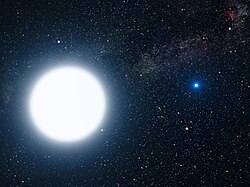Rehua
Rehua ist in der Mythologie der Māori Neuseelands einer der großen Götter, der Sternengott. Er lebt im Himmel beim Götterpaar der Weltenschöpfung Rangi und Papa – dem Himmelvater und der Erdgöttin – und ist deren direkter Sohn.
Rehua ist zudem Vater von Kaitangata und auch Vorfahr des legendären Halbgotts Māui.[1]
Entsprechend einer Legende des Ngāi-Tahu-Stamms auf der Südinsel Neuseelands ist Rehua der älteste Sohn von Rangi und Papa, der zunächst nur als Licht existierte, aber später menschliche Gestalt annahm, bevor er in den Himmel aufstieg. Dort wurde er von seinem Bruder Tāne besucht. Rehua hatte Vögel in seinem Haar. Rehua und seine Diener bereiteten Vögel als Mahl zu für Tāne, was diesen erschreckte, denn die Vögel hatten Läuse von Rehuas Kopf gegessen, was sie tapu, also heilig machte. Rehua schenkte Tāne einige Vögel und auch Bäume, von deren Früchte sich die Vögel ernährten, und Tāne, der Gott der Wälder und Vögel brachte diese Vögel und Bäume von seiner Reise mit. Seither gibt es Wälder und Vögel auf der Erde.[2]
Rehua ist am Himmel ein sehr heller Stern. Für den Tūhoe-Stamm der Māori im Osten der Nordinsel Neuseelands ist Rehua der Stern Antares. Andere sehen ihn in Beteigeuze oder Sirius. Weil er so weit oben im Himmel lebt, bleibt Rehua vom Tod unberührt, hat die Macht, Blinde wieder sehen zu lassen, Tote wiederzuerwecken und Krankheiten zu heilen.[3]
Siehe auch
Literatur
- Margaret Orbell: A Concise Encyclopedia of Māori Myth and Legend. Canterbury University Press, Christchurch 1998, ISBN 0-908812-56-6.
- Edward Tregear: The Maori-Polynesian Comparative Dictionary. Lyon and Blair, Wellington 1891 (Nachdruck. Cadsonbury Publishing, Christchurch 2001).
Einzelnachweise
Auf dieser Seite verwendete Medien
This picture is an artist's impression showing how the binary star system of Sirius A and its diminutive blue companion, Sirius B, might appear to an interstellar visitor. The large, bluish-white star Sirius A dominates the scene, while Sirius B is the small but very hot and blue white-dwarf star on the right. The two stars revolve around each other every 50 years. White dwarfs are the leftover remnants of stars similar to our Sun. The Sirius system, only 8.6 light-years from Earth, is the fifth closest stellar system known. Sirius B is faint because of its tiny size. Its diameter is only 7,500 miles (about 12 thousand kilometres), slightly smaller than the size of our Earth. The Sirius system is so close to Earth that most of the familiar constellations would have nearly the same appearance as in our own sky. In this rendition, we see in the background the three bright stars that make up the Summer Triangle: Altair, Deneb, and Vega. Altair is the white dot above Sirius A; Deneb is the dot to the upper right; and Vega lies below Sirius B. But there is one unfamiliar addition to the constellations: our own Sun is the second-magnitude star, shown as a small dot just below and to the right of Sirius A.

